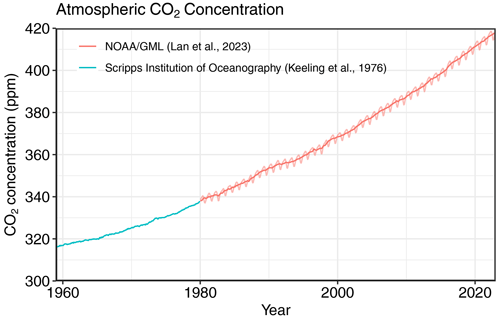2023-12-05 ミュンヘン大学(LMU)
◆デフレーションやエネルギー危機が欧州の減少に寄与し、中国の増加はCovid-19の影響からの遅れが原因。報告書は森林伐採の排出が減少したものの、補うには不十分で、炭素除去技術の拡充が必要と警告。El Niñoの影響で陸地の炭素吸収が減少し、2024年には大気中の二酸化炭素が増加する見通し。パリ協定の目標に達成するには更なる排出削減が不可欠とされています。
<関連情報>
- https://www.lmu.de/en/newsroom/news-overview/news/fossil-co2-emissions-reach-record-high.html
- https://essd.copernicus.org/articles/15/5301/2023/
2023年世界の炭素収支 Global Carbon Budget 2023
Pierre Friedlingstein, Michael O’Sullivan, Matthew W. Jones, Robbie M. Andrew, Dorothee C. E. Bakker, Judith Hauck, Peter Landschützer, Corinne Le Quéré, Ingrid T. Luijkx, Glen P. Peters, Wouter Peters, Julia Pongratz, Clemens Schwingshackl, Stephen Sitch, Josep G. Canadell, Philippe Ciais, Robert B. Jackson, Simone R. Alin, Peter Anthoni, Leticia Barbero, Nicholas R. Bates, Meike Becker, Nicolas Bellouin, Bertrand Decharme, Laurent Bopp, Ida Bagus Mandhara Brasika, Patricia Cadule, Matthew A. Chamberlain, Naveen Chandra, Thi-Tuyet-Trang Chau, Frédéric Chevallier, Louise P. Chini, Margot Cronin, Xinyu Dou, Kazutaka Enyo, Wiley Evans, Stefanie Falk, Richard A. Feely, Liang Feng, Daniel J. Ford, Thomas Gasser, Josefine Ghattas, Thanos Gkritzalis, Giacomo Grassi, Luke Gregor, Nicolas Gruber, Özgür Gürses, Ian Harris, Matthew Hefner, Jens Heinke, Richard A. Houghton, George C. Hurtt, Yosuke Iida, Tatiana Ilyina, Andrew R. Jacobson, Atul Jain, Tereza Jarníková, Annika Jersild, Fei Jiang, Zhe Jin, Fortunat Joos, Etsushi Kato, Ralph F. Keeling, Daniel Kennedy, Kees Klein Goldewijk, Jürgen Knauer, Jan Ivar Korsbakken, Arne Körtzinger, Xin Lan, Nathalie Lefèvre, Hongmei Li, Junjie Liu, Zhiqiang Liu, Lei Ma, Greg Marland, Nicolas Mayot, Patrick C. McGuire, Galen A. McKinley, Gesa Meyer, Eric J. Morgan, David R. Munro, Shin-Ichiro Nakaoka, Yosuke Niwa, Kevin M. O’Brien, Are Olsen, Abdirahman M. Omar, Tsuneo Ono, Melf Paulsen, Denis Pierrot, Katie Pocock, Benjamin Poulter, Carter M. Powis, Gregor Rehder, Laure Resplandy, Eddy Robertson, Christian Rödenbeck, Thais M. Rosan, Jörg Schwinger, Roland Séférian, T. Luke Smallman, Stephen M. Smith, Reinel Sospedra-Alfonso, Qing Sun, Adrienne J. Sutton, Colm Sweeney, Shintaro Takao, Pieter P. Tans, Hanqin Tian, Bronte Tilbrook, Hiroyuki Tsujino, Francesco Tubiello, Guido R. van der Werf, Erik van Ooijen, Rik Wanninkhof, Michio Watanabe, Cathy Wimart-Rousseau, Dongxu Yang, Xiaojuan Yang, Wenping Yuan, Xu Yue, Sönke Zaehle, Jiye Zeng, and Bo Zheng
Earth System Science Data Published:05 Dec 2023
DOI:https://doi.org/10.5194/essd-15-5301-2023

Abstract
Accurate assessment of anthropogenic carbon dioxide (CO2) emissions and their redistribution among the atmosphere, ocean, and terrestrial biosphere in a changing climate is critical to better understand the global carbon cycle, support the development of climate policies, and project future climate change. Here we describe and synthesize data sets and methodology to quantify the five major components of the global carbon budget and their uncertainties. Fossil CO2 emissions (EFOS) are based on energy statistics and cement production data, while emissions from land-use change (ELUC), mainly deforestation, are based on land-use and land-use change data and bookkeeping models. Atmospheric CO2 concentration is measured directly, and its growth rate (GATM) is computed from the annual changes in concentration. The ocean CO2 sink (SOCEAN) is estimated with global ocean biogeochemistry models and observation-based fCO2 products. The terrestrial CO2 sink (SLAND) is estimated with dynamic global vegetation models. Additional lines of evidence on land and ocean sinks are provided by atmospheric inversions, atmospheric oxygen measurements, and Earth system models. The resulting carbon budget imbalance (BIM), the difference between the estimated total emissions and the estimated changes in the atmosphere, ocean, and terrestrial biosphere, is a measure of imperfect data and incomplete understanding of the contemporary carbon cycle. All uncertainties are reported as ±1σ.
For the year 2022, EFOS increased by 0.9 % relative to 2021, with fossil emissions at 9.9±0.5 Gt C yr−1 (10.2±0.5 Gt C yr−1 when the cement carbonation sink is not included), and ELUC was 1.2±0.7 Gt C yr−1, for a total anthropogenic CO2 emission (including the cement carbonation sink) of 11.1±0.8 Gt C yr−1 (40.7±3.2 Gt CO2 yr−1). Also, for 2022, GATM was 4.6±0.2 Gt C yr−1 (2.18±0.1 ppm yr−1; ppm denotes parts per million), SOCEAN was 2.8±0.4 Gt C yr−1, and SLAND was 3.8±0.8 Gt C yr−1, with a BIM of −0.1 Gt C yr−1 (i.e. total estimated sources marginally too low or sinks marginally too high). The global atmospheric CO2 concentration averaged over 2022 reached 417.1±0.1 ppm. Preliminary data for 2023 suggest an increase in EFOS relative to 2022 of +1.1 % (0.0 % to 2.1 %) globally and atmospheric CO2 concentration reaching 419.3 ppm, 51 % above the pre-industrial level (around 278 ppm in 1750). Overall, the mean of and trend in the components of the global carbon budget are consistently estimated over the period 1959–2022, with a near-zero overall budget imbalance, although discrepancies of up to around 1 Gt C yr−1 persist for the representation of annual to semi-decadal variability in CO2 fluxes. Comparison of estimates from multiple approaches and observations shows the following: (1) a persistent large uncertainty in the estimate of land-use changes emissions, (2) a low agreement between the different methods on the magnitude of the land CO2 flux in the northern extra-tropics, and (3) a discrepancy between the different methods on the strength of the ocean sink over the last decade.
This living-data update documents changes in methods and data sets applied to this most recent global carbon budget as well as evolving community understanding of the global carbon cycle. The data presented in this work are available at https://doi.org/10.18160/GCP-2023 (Friedlingstein et al., 2023).



